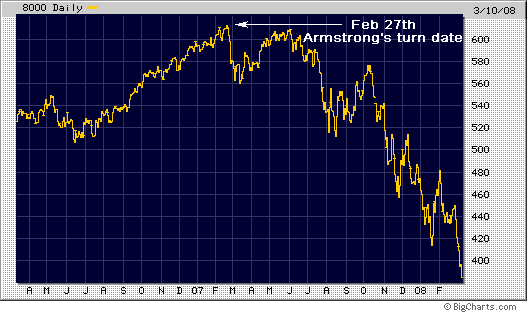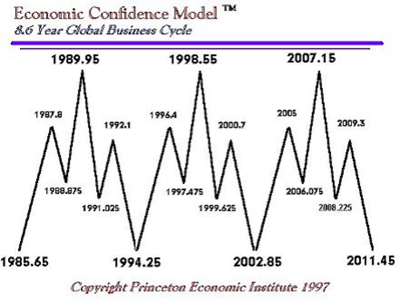Why the US rate cut is good news for gold
The US central bank cut rates by .75 yesterday - and, oddly, gold then fell $25 whilst the dollar rose. The markets may be a little calmer for now, but the fear will return, says Dominic Frisby.
This feature is part of our FREE daily Money Morning email. If you'd like to sign up, please click here: Sign up for Money Morning
Sound the trumpets and bang the drums - we have $1,000 gold.
Well, we did.
MoneyWeek
Subscribe to MoneyWeek today and get your first six magazine issues absolutely FREE

Sign up to Money Morning
Don't miss the latest investment and personal finances news, market analysis, plus money-saving tips with our free twice-daily newsletter
Don't miss the latest investment and personal finances news, market analysis, plus money-saving tips with our free twice-daily newsletter
And then the Federal Reserve lowers interest rates by of a point and gold sells off $25, after a $20 sell-off the day before. Meanwhile, the dollar rises. It doesn't make sense. Anyone would think the gold market was being manipulated
Why the correction in gold?
It's too easy to jump in and say that the gold market is fixed every time gold sells off.
Of course, there's no doubt the Fed and its allies would not have wanted gold rocketing upwards just as they made their next interest rate cut. A rising gold price tells investors that something is rotten in the state of Denmark (as if Bear Stearns wasn't evidence enough). So I'm sure the Fed will have been at least pleased to note yesterday's falls, even if they didn't cause them. But let's look at some other possible reasons for the $50 sell-off.
Perhaps it has more to do with trader and investor psychology. Fear seemed to peak over the weekend - there was that emergency point cut in the Fed's lending rate, and gold spiked above $1,020. For all the fiscal irresponsibility of the Fed's move to lower rates, it has, for the time being, calmed markets until the next bank goes belly-up. Nevertheless, a calmer market has less need of gold.
To add the fear there is a certain amount of disappointment. Many speculators seemed to have been expecting a full point cut. When their expectations were frustrated, they sold off.
This has been a prime example of the power of expectation management. Under normal circumstances, the dollar would have plunged and gold soared on a .75% cut. But, thanks to the way this has been spun, the Fed can almost that this was a prudent, inflation-fighting move, just because they didn't go all out with a full 1%.
The Fed's move is still good for gold
Though effective, this hint of prudence is pure nonsense, and some basic realities should soon dawn again. The move is inflationary. In its policy of socialism for the rich', the Fed is trying to bail out the banks and the stock markets. They just made money easier, when it is easy money that is at the root of all this mess. They are attempting to solve the problem with the very cause of the problem.
The intended consequence of this move is to increase the amount of dollars in circulation in order to ease the globally liquidity crisis. But the inevitable consequence of more of anything in circulation is a decrease in its exclusivity, its premium, its value, its purchasing power. The Fed have just made the long-term problems for the dollar and by extension all paper currencies even worse. Meanwhile, they have not increased the amount of gold in circulation. What they have done is bullish for gold, so sit tight.
If you're a technical trader, then you should look for a first line of support around $970 at the 21-day moving average. If it goes there and holds that is very good for the technical picture. Gold will have retraced, consolidated and be gathering cause for the next move up, unlike April 2006 when it overextended itself. If it does this, it is good for gold. It will prolong the duration of this run. I may even begin revising up my target high for the year of $1,150-£$1,200
I say again, yesterday was sophistry. It has created another opportunity not only to buy gold, but an even greater opportunity to short the banks once again. On yesterday's price action you would think the banks had just announced record profits. They haven't. The problems are still there. Once the dust settles, fear will return.
The mother of all market calls
I was planning to make this next item the main feature of today's piece, but it got upstaged by yesterday's rate cut.
Some of you will remember the brutal sell-off in the stock markets on February 27th last year, at the time the worst day in the markets since the terrorist attacks of September 11th. Others will also remember that the sell-off had been predicted some eight years previously in 1999 by one Martin Armstrong, who we wrote about a year or so ago. See: The strange case of the jailed market genius.
It was just one of many of the now-imprisoned financial analyst's spectacular stock market predictions; among them the 1987 stock market crash, the 1989 high in the Nikkei, the July 20th high in US equities (nailed to the day) and the current boom in gold and oil.
His predictions are based on a model he developed in the 1970s. There is an intense turning point in financial markets every 51.6 years, he believes, with investor confidence churning on a smaller 8.6-year cycle. This 8.6-year cycle was related to pi 8.6 years is equal to 3,141 days.
However, critics will point out rightly that the stock markets did not peak on Feb 26th, 2007, they merely corrected. The peak came in July. That's fair enough but now look at this chart of the Dow Jones Financials.

Amazing, isn't it? That peak was predicted in 1999!
Here we see a copy of his economic cycle:

You should note that an intermediate turn date (in other words, a short-term rally in a longer-term downtrend) is scheduled for 2008.225 or March 22nd, 2008, this Saturday.
Now a Saturday bang in the middle of Easter would be an odd day for the stock market to rally, so perhaps Armstrong was wrong. Perhaps that bear market rally in the financials began yesterday or perhaps we'll see a turning point in a different market altogether. We'll soon find out I'll keep an eye out and get back to you with my thoughts next week.
Turning to the wider markets...
Enjoying this article? Why not sign up to receive Money Morning FREE every weekday? Just click here: FREE daily Money Morning email
Triple-figure gains as financials rebound
In London, the FTSE 100 index added 191 points to close at 5,605 yesterday as Wall Street opened brightly on expectations that the FOMC would cut rates. The financial sector was given a boost by better-than-expected earnings for Lehman Brothers and Goldman Sachs, with Man Group and ICAP making the best blue-chip gains of the day. For a full market report, see: London market close.
Elsewhere in Europe, the Paris CAC-40 gained 151 points to end the day at 4,582. Over in Frankfurt, the DAX-30 added 211 points to close at 6,393.
On Wall Street, stocks soared yesterday as the Fed's rate cut combined with good news from Lehman Brothers and Goldman Sachs (which added 11.7% and 32.6% respectively) cheered investors. The Dow Jones surged to its fourth-largest points gain ever, adding 420 points to close at 12,392. The tech-rich Nasdaq was 91 points higher, at 2,286. And the broader S&P 500 added 54 points to end the day at 1,330.
Asian markets also advanced, led by financial stocks, although gains were more muted. The Japanese Nikkei rose 296 points to end the session at 12,260. And in Hong Kong, the Hang Seng added 482 points, ending the day at 21,866.
Sterling tumbles on rate cut minutes
Crude oil futures had fallen to $108.76 this morning, and Brent spot had fallen to $105.52.
Spot gold was trading at $980.80 this morning, just above yesterday's weekly low of $977.80. Silver had edged up to $19.88.
In the currency markets, the pound was out of favour this morning following the publication of the latest BoE minutes showing two members of the committee favoured a rate cut this month. Sterling had fallen to 2.0020 against the dollar and 1.2710 against the euro. And the dollar was at 98.32 against the yen and 0.6346 against the euro.
And in London this morning, official figures showed that unemployment fell to its lowest level in three decades in February. The number of people seeking jobless benefits fell 2,800 to 793,500. However, as Deutsche Bank economist George Buckley warned, employment is a lagging indicator; jobs growth is down to 'past economic gains' whilst 'the labor market tends to turn down a few quarters after growth starts slowing'.
Our recommended articles for today...
The best dollar hedge
- Gold broke through the $1,000 market last week and fellow commodities - along with the yen and the euro - have also been soaring. All of these are good ways to hedge the falling dollar, but one is set to outperform all the others. To find out what it is - and why you should keep an eye out for a gold bubble - read: The best dollar hedge.
Britain finally realises that you can go wrong with property
- For years Britons have been using cheap credit to by houses for no better reason than that the price of houses was going up. But suddenly both the cheap money and the blind faith are gone. It's all downhill from here. For more from Merryn Somerset Webb on why she'd rather invest in mortgage backed securities than a Central London property fund, read: Britain finally realises that you can go wrong with property.
Get the latest financial news, insights and expert analysis from our award-winning MoneyWeek team, to help you understand what really matters when it comes to your finances.
MoneyWeek is written by a team of experienced and award-winning journalists, plus expert columnists. As well as daily digital news and features, MoneyWeek also publishes a weekly magazine, covering investing and personal finance. From share tips, pensions, gold to practical investment tips - we provide a round-up to help you make money and keep it.
-
 How to profit from the markets’ pessimism about Britain
How to profit from the markets’ pessimism about BritainOpinion There was little in the Budget to prop up Britain's stock market, but opportunities are hiding in plain sight. Investors should take advantage while they can
-
 London claims victory in the Brexit wars
London claims victory in the Brexit warsOpinion JPMorgan Chase's decision to build a new headquarters in London is a huge vote of confidence and a sign that the City will remain Europe's key financial hub

